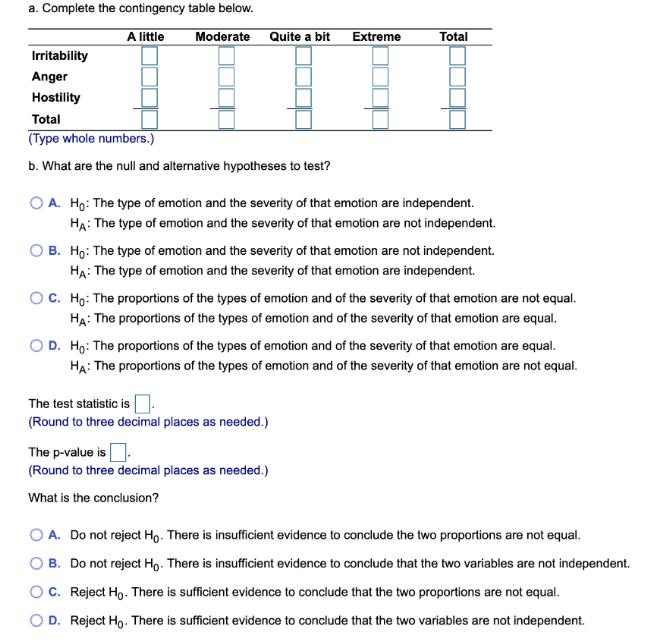An article in USA TODAY reported on a study conducted by Daniel Vinson on the relationship between anger and propensity to be injured. Suppose the
An article in USA TODAY reported on a study conducted by Daniel Vinson on the relationship between anger and propensity to be injured. Suppose the file titled Angry contains data on the emotions reported by a sample of patients just before they were injured.
a. Use the data in the file to construct a contingency table.
b. Determine if the type of emotion felt by patients just before they were injured is independent of the severity of that emotion. Use a contingency analysis and a significance level of 0.05.

a. Complete the contingency table below. A little Moderate Extreme Quite a bit Total Irritability Anger Hostility Total (Type whole numbers.) b. What are the null and alternative hypotheses to test? O A. Ho: The type of emotion and the severity of that emotion are independent. HA: The type of emotion and the severity of that emotion are not independent. B. Ho: The type of emotion and the severity of that emotion are not independent. HA: The type of emotion and the severity of that emotion are independent. OC. H: The proportions of the types of emotion and of the severity of that emotion are not equal. Ha: The proportions of the types of emotion and of the severity of that emotion are equal. O D. Ho: The proportions of the types of emotion and of the severity of that emotion are equal. H: The proportions of the types of emotion and of the severity of that emotion are not equal. The test statistic is (Round to three decimal places as needed.) The p-value is (Round to three decimal places as needed.) What is the conclusion? O A. Do not reject Ho. There is insufficient evidence to conclude the two proportions are not equal. O B. Do not reject Ho. There is insufficient evidence to conclude that the two variables are not independent. C. Reject Ho. There is sufficient evidence to conclude that the two proportions are not equal. D. Reject Ho. There is sufficient evidence to conclude that the two variables are not independent.
Step by Step Solution
3.41 Rating (154 Votes )
There are 3 Steps involved in it
Step: 1
a Contigency table Observed data Quite a Modrate bit A ...
See step-by-step solutions with expert insights and AI powered tools for academic success
Step: 2

Step: 3

Ace Your Homework with AI
Get the answers you need in no time with our AI-driven, step-by-step assistance
Get Started


